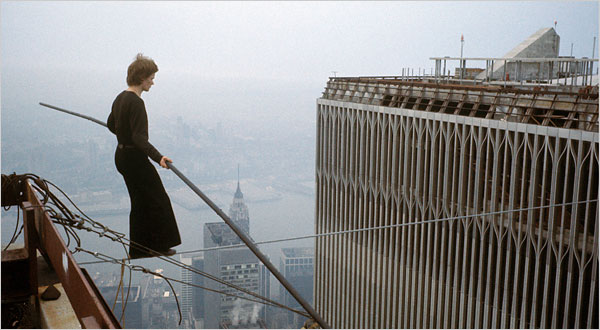 ARTS & IDEAS FEST: Metaphor for life? Existential act of faith? Amazing, perhaps foolhardy, display of skill and courage? Illegal act of art terrorism? Phillippe Petit’s tightrope act between the twin towers of the World Trade Center on August 4, 1974, might well be all these things and more. One thing for sure: it defined the idea of “working without a net.”
ARTS & IDEAS FEST: Metaphor for life? Existential act of faith? Amazing, perhaps foolhardy, display of skill and courage? Illegal act of art terrorism? Phillippe Petit’s tightrope act between the twin towers of the World Trade Center on August 4, 1974, might well be all these things and more. One thing for sure: it defined the idea of “working without a net.”
As told in Man on Wire, the Oscar-winning film by James Marsh, Petit’s act is the logical conclusion of a life spent creating great public spectacles of derring-do. As he says “there is no why,” which might be another way of saying “because it’s there,” the classic reply to the question of why one attempts Mt. Everest. Unlike some accomplishments in that vein, though, Petit’s 40-minute catwalk on a cable stretched the 200 feet between the towers and a quarter of a mile in the air was on view to the world.
The film, which also won the World Cinema Jury Award and the Audience Award at Sundance 2008, lets us get to know Petit without trying to explain him or his art. Marsh recreates the event as a “heist film”—it’s apt, since planning and executing this act required the kind of stealth and security-thwarting smarts needed for a successful bank robbery.
Or, we might think, for a terrorist assault. Though the ultimate fate of the towers is never mentioned in the film, it’s hard to watch the film now without thinking about the implications of how easily these guys got in there and did their thing. How do you get a 450-pound cable and 26-foot balancing pole to the top of the World Trade Center in the dead of night? It took six years of planning and many visits to the towers while under construction.
We might shake our heads now over lax security, but things were different in 1974: the towers had only been open for a little over a year when Petit made his wondrous walk, and weren’t the symbols of our national wound or of much of anything other than the will to build higher. The bravado of Petit’s act matches the bravado of building something so high in the first place, which did have its critics at the time. The reminiscences of the participants have an air of wondering disbelief even at this remove, but for Petit the act is simply the culmination of a life’s work, and the dream of walking between the towers began around the time their construction commenced.
Along the way to the goal, there are also great walks, also depicted here, between the towers of Notre Dame Cathedral in 1971 and between two of the pylons on the Sydney Harbor Bridge in 1973. Each is impressive, but it’s the dance between the World Trade Center towers that, even then, had the feel of an ultimate stunt. Now, a film on the act can’t help being freighted with so many feelings about what befell the towers—the film benefits from the sense of magically resurrecting the towers and showing a skilled, almost pixie-ish Frenchmen levitate between them.
Unfortunately, the person who was to film the event at the time failed to do his job—perhaps the only part of the stunt that didn’t go according to plan—and so there’s less footage of the event than one would like. What we do see is so compelling, as a visual image and as an act of human ingenuity and grace, that one wishes there were more, particularly as we know this is a once in a lifetime event that could never happen now.
Check out this classic news footage of Petit's wire-walk. [youtube]http://www.youtube.com/watch?v=lAVj2IVC9ko[/youtube]
IF YOU GO:
What: Man on a Wire and "Nothing Is Impossible," a lecture by Philippe Petit When: June 16, 11 a.m. and 3 p.m., respectively Where: Yale University Art Gallery, 111 Chapel St. Tickets: Free Info: artidea.org
Why are we doing this? Click here to find out more.
